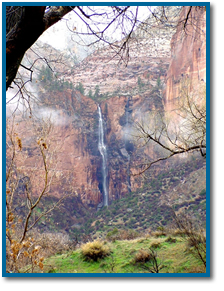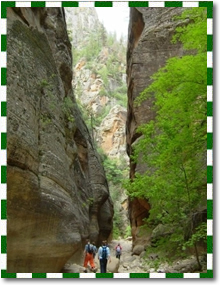 Zion National Park, in the southwest corner of Utah, is Utah's oldest and most visited national park receiving
around three million visitors each year. The Anasazi people were the first inhabitants of Zion National Park, they
occupied the canyon until about 800 years ago. Their abandoned cliff houses and rock art are scattered throughout Zion
Canyon. After the Anasazi, the Paiute Indians began to inhabit Zion. The first settlers, members of the Mormon Church,
arrived in the park in 1858. The settlers called their new home Zion Canyon. In 1872 John Wesley Powell surveyed the
area and recorded the canyon's Indian name, Mukuntuweap. It was under this name that the canyon was designated a
national monument on 31 July 1909. In 1918 it was renamed Zion National Monument and in 1919 received national park
status. Zion National Park, in the southwest corner of Utah, is Utah's oldest and most visited national park receiving
around three million visitors each year. The Anasazi people were the first inhabitants of Zion National Park, they
occupied the canyon until about 800 years ago. Their abandoned cliff houses and rock art are scattered throughout Zion
Canyon. After the Anasazi, the Paiute Indians began to inhabit Zion. The first settlers, members of the Mormon Church,
arrived in the park in 1858. The settlers called their new home Zion Canyon. In 1872 John Wesley Powell surveyed the
area and recorded the canyon's Indian name, Mukuntuweap. It was under this name that the canyon was designated a
national monument on 31 July 1909. In 1918 it was renamed Zion National Monument and in 1919 received national park
status.
One early visitor to Zion Canyon was an artist named Frederick S. Dellenbaugh; he spent part of the summer of 1903
painting in Zion Canyon. His paintings were exhibited at the 1904 St. Louis World's Fair. In January of that same year
Dellenbaugh published an article about Zion National Park in Scribner's Magazine. The article, "A New Valley of Wonders,"
described Dellenbaugh's first view of the Great Temple, which stands at the entrance to Zion Canyon: "One hardly knows
just how to think of it. Never before has such a naked mountain of rock entered our minds. Without a shred of disguise
its transcendent form rises pre-eminent. There is almost nothing to compare to it. Niagara has the beauty of energy; the
Grand Canyon of immensity; the Yellowstone of singularity; the Yosemite of altitude; the ocean of power; this Great
Temple of eternity."
 Zion National Park is home to a diverse collection of geological wonders, including formations such as the towering
2,200-foot Great White Throne, the park's most famous landmark; the Court of the Patriarchs; the Sentinel; the Watchman;
Checkerboard Mesa; Kolob Arch, a 310 ft. long arch and the world's largest known natural span; and the Narrows of the
Virgin River, where a person can walk upstream to places so narrow that both sides of the canyon walls with your
outstretched hands. Zion National Park is home to a diverse collection of geological wonders, including formations such as the towering
2,200-foot Great White Throne, the park's most famous landmark; the Court of the Patriarchs; the Sentinel; the Watchman;
Checkerboard Mesa; Kolob Arch, a 310 ft. long arch and the world's largest known natural span; and the Narrows of the
Virgin River, where a person can walk upstream to places so narrow that both sides of the canyon walls with your
outstretched hands.
The lowest point in the park is Coalpits Wash at 3,666 ft (1,128m); the highest point is Horse Ranch Mountain in the
Kolob Canyons section which sits at 8,726 ft (2,660 m) above sea level. The differences in elevation, sunlight, water,
and temperature within Zion National Park create "microenvironments", like hanging gardens, forested side canyons, and
isolated mesas that lend to this diversity. Within Zion canyon there are 75 species of mammals, 271 birds, 32 reptiles
and amphibians. Commonly seen animals include mule deer, rock squirrels, lizards, and many species of songbirds. Rare
or endangered species include Peregrine Falcons, Mexican Spotted Owls, spinedace (a fish), and other species such as
the Zion snail which is found nowhere else on earth.
Zion National Park has gained worldwide recognition for its beauty and grandeur, and currently receives around 3
million visitors each year The park has two visitor centers, one at the entrance to Kolob Canyon and the main visitor
center at the south entrance to the park. |